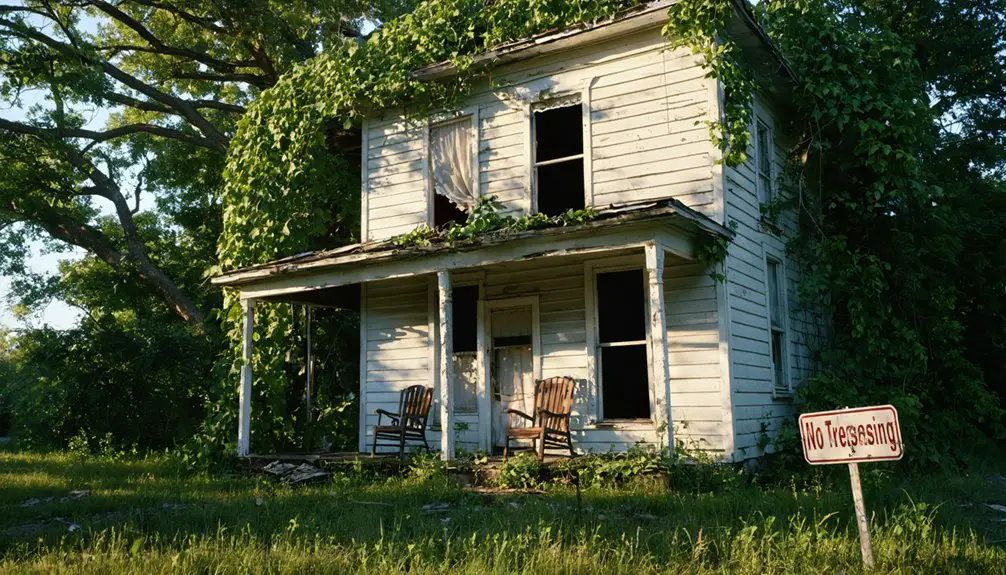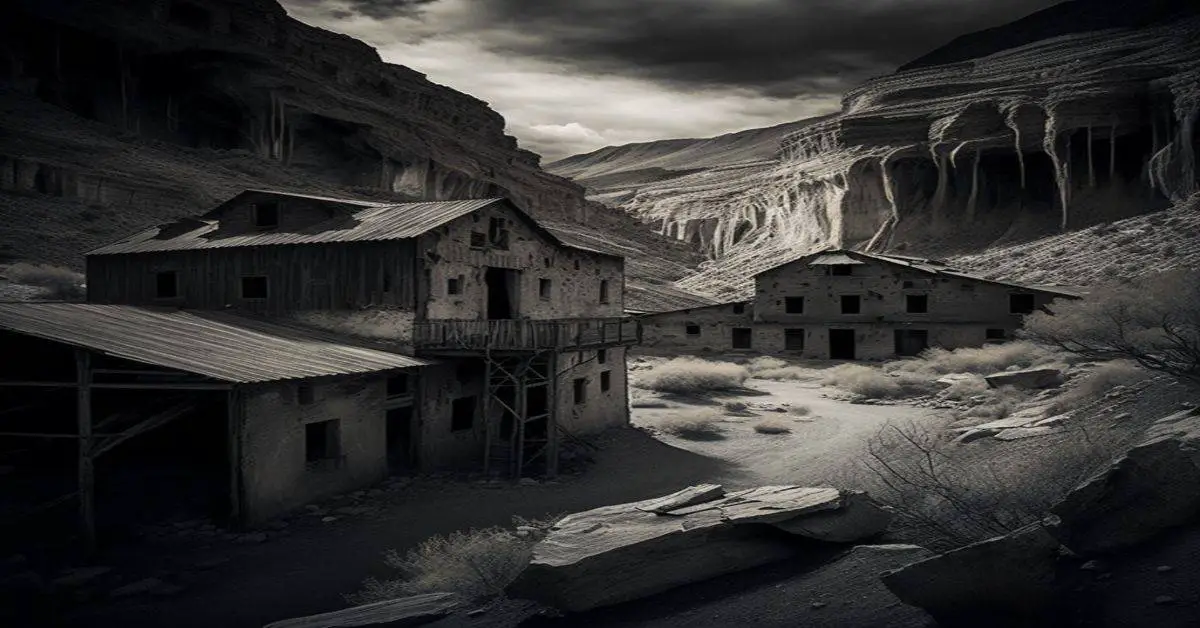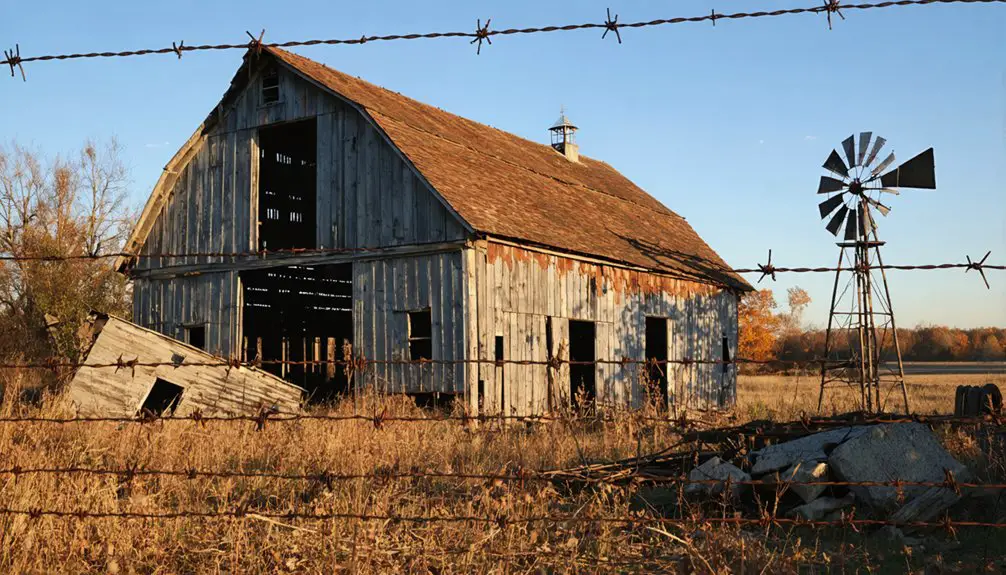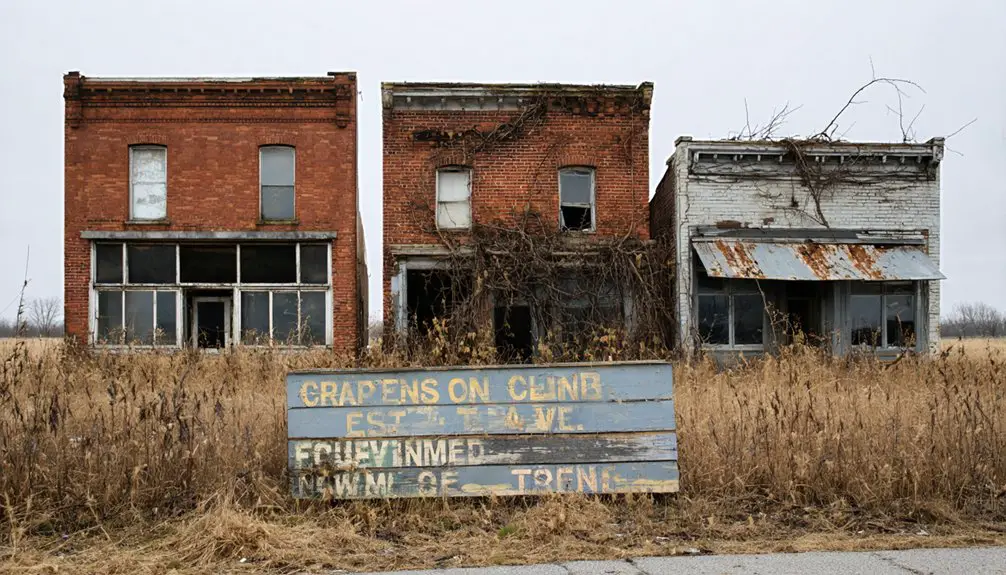You’ll find Knockemstiff’s notorious ghost town tucked away in Ross County, Ohio, where Colonel Abraham Hegler first settled in 1805. Originally home to Native American tribes and later known for moonshine operations and frequent bar fights, the town’s population peaked at several hundred residents before declining to just 200 today. While abandoned buildings and a missing bullet-riddled town sign mark its current state, Knockemstiff’s dark legacy lives on through Donald Ray Pollock’s haunting stories.
Key Takeaways
- Knockemstiff’s population declined from several hundred residents to approximately 200 people due to economic decline and workforce migration to cities.
- Most buildings in Knockemstiff are abandoned, with only historic landmarks like Shady Glen Church and the old general store remaining.
- The town’s infrastructure deteriorated after major employers left, leaving no new construction and limited community maintenance.
- A missing town sign, destroyed by gunfire, symbolizes Knockemstiff’s transformation from a thriving settlement into a near-ghost town.
- The unincorporated community lacks municipal buildings and preserved structures, with older single-family homes dominating the deteriorating landscape.
The Fascinating Origins Behind the Name
While the exact origin of Knockemstiff’s peculiar name remains disputed, three compelling theories have emerged from the town’s colorful history.
The first involves preacher advice to scorned women, suggesting they “knock ’em stiff” when dealing with unfaithful men.
Hell hath no fury like a preacher’s guidance to scorned women: knock those cheating men stiff and cold.
You’ll find the second theory rooted in the town’s moonshine legacy, where potent local spirits earned nicknames like “Coffin Varnish” and “Stagger Soup.” The powerful brew’s ability to knock drinkers stiff possibly inspired the town’s name during Prohibition. Today, the area appears eerily quiet with just an old gasoline pump remaining.
The third explanation stems from the area’s notorious bar fights, where patrons regularly knocked each other stiff in local taverns. A documented 1896 vandalism case involving William Lightle and the Concord Boys demonstrated the town’s reputation for trouble.
Though the town was alternatively known as Shady Glenn, Knockemstiff stuck and has endured for over a century.
Life in Early Knockemstiff: A Wild Reputation
During its early years, Knockemstiff earned its reputation as one of Ohio’s wildest settlements, where daily bar fights and moonshining defined local life.
You’d find violent gatherings breaking out regularly in taverns, with brawlers getting “knocked stiff” so often that it became the town’s namesake.
The moonshine economy fueled much of the chaos, with illegal distilling operations scattered throughout the area.
Today, only ruins and foundations remain of the bars and stores that once made this community infamous.
You couldn’t escape the rowdiness even in seemingly peaceful places – fights would erupt in candy stores, and poker games frequently turned violent.
Even the local church couldn’t tame the disorder, as evidenced by the famous tale of a preacher witnessing two women fighting over a man.
Located at the intersection of Black Run Road and Shady Glen Road, the hamlet became a focal point for the area’s notorious activities.
From Boom to Bust: Population and Development
You’d find Knockemstiff’s most significant growth in the early 1800s, when Colonel Abraham Hegler’s 1,000-acre settlement attracted farming families and established the community’s agricultural foundation.
While Ross County’s population surged from 8,540 to 40,307 between 1800 and 1880, Knockemstiff’s growth stagnated due to its missed railroad connections and limited economic diversification beyond farming. Multiple disambiguation articles exist about Ross County due to its various geographical associations.
The town gained notoriety over the years for its tough bar fights, with many residents recounting tales of the rowdy atmosphere that characterized the community.
Peak Settlement Era
As Knockemstiff reached its peak settlement era, the unincorporated community sustained a modest population of several hundred residents spread across northeastern Huntington Township in Ross County.
Historical anecdotes tell of a rough-and-tumble frontier atmosphere, where ghost stories circulated about moonshine runners and late-night brawls that gave the settlement its memorable name.
You’d have found a mix of small family homes and scattered farms connected by unpaved rural roads leading to Chillicothe, about 8.5 miles northeast.
The mainly white Appalachian settlers made their living through farming and local trade, with some dabbling in moonshining.
While lacking formal municipal services, the community functioned through informal networks, local churches, and gathering spots where residents maintained close-knit social bonds despite their dispersed settlement pattern. The area falls within the Eastern Time Zone, reflecting its geographical position in rural Ohio.
Situated at an elevation of 708 feet, the community’s hilltop location provided settlers with natural vantage points over the surrounding countryside.
Population Decline Factors
The sequential departure of major employers from Knockemstiff and its surrounding region triggered a devastating chain of economic decline. As shoe manufacturers, the steel mill, and the Piketon uranium enrichment plant closed, economic opportunities vanished.
You’ll find the impact extended far beyond lost jobs, as community resilience crumbled under mounting pressures. Many residents commute to jobs in Columbus for work due to the lack of local opportunities.
- Drug trade infiltrated the area, establishing “dope houses” and increasing crime rates
- Hospital became the largest employer as population aged and health declined
- Young workforce migrated north or to urban centers seeking better prospects
- Vacant storefronts and deteriorating infrastructure deterred new investment
- Declining tax base limited funding for essential community maintenance
These interconnected factors accelerated Knockemstiff’s transformation from a bustling settlement to a ghost town, leaving behind an aging population and fractured community structure.
Modern Residential Patterns
Residential patterns in Knockemstiff reveal a stark shift from its early roots as a stable rural settlement to today’s sparsely populated community. You’ll find only about 200 residents scattered across the landscape, marking a significant residential decline from the town’s more vibrant past.
Local author Donald Ray Pollock still lives just eight miles away in nearby Chillicothe, providing an authentic voice for the town’s evolving story. The community’s layout still centers around historic landmarks like the Shady Glen Church and general store, preserving a traditional rural character. You’ll notice older single-family homes dominating the area, with virtually no new construction reshaping the landscape.
While community identity remains strong, the unincorporated status has limited infrastructure development and modernization. The residential organization follows the same pattern established in the early-mid 20th century, with homes spread along roads like Shady Glen Road, resisting the suburbanization that’s transformed other rural areas.
Notable Landmarks and Infrastructure
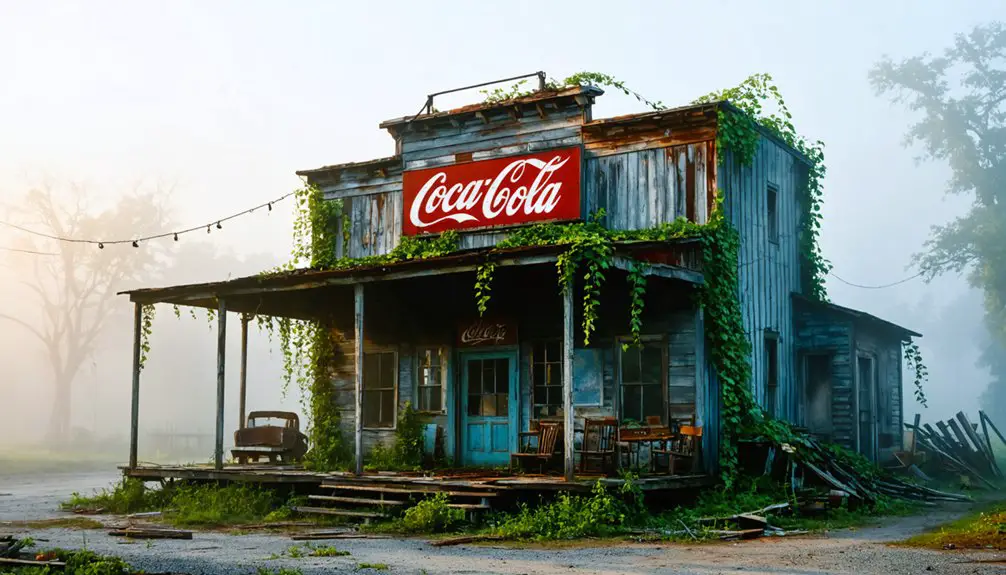
Modern-day visitors to Knockemstiff won’t find many remaining landmarks, as most structures have succumbed to abandonment and decay.
The most significant remnant of the town’s infrastructure is an old general store with its vintage gas pump, standing as a silent witness to the community’s former liveliness.
While the surrounding landscape offers beautiful rural scenery, the town’s physical infrastructure has largely disappeared into history.
- Old general store building with vintage gas pump remains as the primary landmark
- Former Shady Glen Church and school locations along Shady Glen Road mark historical community centers
- Missing town sign, reportedly destroyed by gunfire, symbolizes the area’s decline
- Historical moonshine production sites, though locations remain undocumented
- No preserved railroad infrastructure or official municipal buildings exist
Cultural Impact and Literary Legacy
While now a ghost town, Knockemstiff’s most enduring legacy lives on through Donald Ray Pollock’s influential short story collection that shares the town’s name.
The book’s cultural significance extends beyond its pages, drawing attention to this forgotten corner of Ohio while challenging romanticized views of small-town America.
The work’s literary influence continues to shape contemporary Gothic and grotesque storytelling traditions. You’ll find Pollock’s raw, unsettling style compared to masters like Shirley Jackson and Edgar Allan Poe.
Through interconnected stories of violence, addiction, and despair, the collection explores themes that resonate with broader social issues. The town’s tough, moonshine-fueled reputation informs these narratives, while scholarly analyses emphasize how the work reflects cycles of poverty and social breakdown in rural America.
Native American Heritage and Pioneer Settlement
Before pioneer settlement in what would become Knockemstiff, you’ll find evidence of Fort Ancient culture‘s presence through archaeological sites and artifacts dating back to 1000 CE.
You can trace the first European-American settlements in the area to the early 1800s, when pioneers began clearing forested lands for agriculture.
The Hegler family, among the earliest pioneer settlers, established significant land holdings in 1805 that would later influence the development of Knockemstiff’s community boundaries.
Fort Ancient Cultural Legacy
Along the banks of the Ohio River valley, the Fort Ancient culture thrived between 1000 and 1750 CE, establishing a rich cultural legacy that extended through modern-day Ohio, western West Virginia, northern Kentucky, and southeastern Indiana.
You’ll find evidence of their remarkable achievements in earthwork construction, agricultural innovation, and extensive trade networks that shaped the region’s cultural significance.
- Built North America’s largest hilltop enclosure spanning 126 acres
- Constructed ceremonial earthworks reaching heights of 23 feet with 67 gateways
- Introduced maize agriculture, revolutionizing settlement patterns
- Traded exotic materials from the Southeast to the Great Lakes
- Left behind marine shell gorgets and obsidian artifacts showing continental connections
The Fort Ancient culture’s sophisticated engineering and ceremonial practices demonstrate their mastery of the land and their influence on Native American heritage across the continent.
Early Land Settlement Patterns
Throughout Ohio’s rich history, Native American tribes including the Shawnee, Potawatomi, Erie, and Kickapoo established complex settlement patterns that shaped the region’s early development.
You’ll find their communities were strategically positioned along waterways and fertile lands, where they built permanent settlements and practiced agriculture alongside hunting and gathering.
The dynamics shifted dramatically after the American Revolution when treaties like Fort Stanwix and Greenville forced land cessions from native peoples.
You’d have seen rapid changes as pioneer settlers claimed newly opened territories, driven by land speculation and veteran grants.
The Northwest Ordinance of 1787 accelerated this evolution, establishing frameworks for statehood and settlement.
What was once a landscape of native communities and earthwork mounds quickly became a patchwork of pioneer farms, marking a definitive cultural and territorial shift in Ohio’s history.
Hegler Family Pioneer Impact
When Colonel Abraham Hegler arrived in Ross County from Hardy County, West Virginia in the early 1800s, he’d establish one of the most influential pioneer legacies in Knockemstiff’s history.
The War of 1812 veteran’s agricultural influence stretched across 1,000 acres, where he’d raise livestock and develop farmland that sustained the local economy throughout the 19th century.
- Built a barn that served as the community’s first church until 1818
- Married twice, expanding family influence through multiple generations
- Contributed to establishing permanent settlements in previously Native American territory
- Maintained agricultural dominance despite lack of railroad development
- Left lasting impact through Mallow Cemetery burial grounds, where pioneer and Native American heritage intersect
Frequently Asked Questions
What’s the Nearest Major City to Knockemstiff?
Like a beacon in rural Ohio’s rolling hills, you’ll find Chillicothe’s your nearest major city, with its rich local history and nearest attractions just a short drive east-northeast from your location.
Are There Any Ghost Tours or Paranormal Investigations in Knockemstiff?
You won’t find organized ghost tours or paranormal investigations in this area. While surrounding cities offer ghost sightings and paranormal experiences, there aren’t any documented haunted tours specifically targeting this location.
What Happened to the Original Knockemstiff School Building?
By 1950, one of 16 original township schools vanished. You won’t find the original structure standing today – it was either demolished or severely altered during the mid-century’s push for educational consolidation.
Can Visitors Still Find Remnants of Old Moonshine Operations?
You won’t find visible distillation evidence or moonshine history at the site today. Any remaining physical traces have vanished over time, leaving only local stories about the area’s notorious bootlegging past.
Which Famous People or Celebrities Have Visited Knockemstiff?
Keep your eyes peeled, but there aren’t any confirmed famous visitors or celebrity sightings, except for Donald Ray Pollock who grew up there and wrote stories about the town.
References
- https://theohioproject.net/places/whats-in-a-name-knockemstiff-ohio/
- https://www.ghosttowns.com/states/oh/knockemstiff.html
- https://en.wikipedia.org/wiki/Knockemstiff
- https://www.bookreporter.com/reviews/knockemstiff
- https://ohioghosttowns.org/ross-county/
- https://jafabrit.blogspot.com/2016/05/backroads-usa-and-town-called.html
- https://wheninyourstate.com/ohio/11-ohio-towns-with-names-so-weird-youll-think-were-making-them-up/
- https://www.elevenwarriors.com/ohio/2017/07/83502/discover-ohio-series-best-name
- https://dash.harvard.edu/server/api/core/bitstreams/2d35b1bf-b9a6-4d5b-ae56-cbcea2af57f4/content
- https://screenrant.com/devil-all-time-netflix-movie-knockemstiff-real-town-explained/
